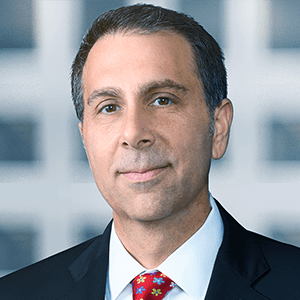-
Fixed Income Perspectives
Opportunities Emerge As Yields Shift Into High Gear
November 2024
- Filename
- Fixed Income Perspectives NOVEMBER 2024.pdf
- Format
- application/pdf
TRANSCRIPT
November marked the start of several market moving events. The October labor report fell short of expectations with disruptions from two hurricanes and a labor strike complicating the data. The unemployment rate held steady at 4.1%. And while U.S. inflation has been easing, recent data showed progress has slowed as consumer spending remains intact.
The market has also been focused on the U.S. election results. With president-elect Trump set to lead a Republican-controlled Congress, the outcome suggests potential policy shifts will impact the business environment and broader economy.
Finally, in line with market expectations, the Federal Reserve cut the overnight lending rate by 25 basis points, its second cut this easing cycle. Forward guidance continues to show an additional cut is in play at the Fed's December meeting. While the committee remains patient in evaluating incoming data and will base future decisions on the economy's underlying strength, growing expectations suggest a less aggressive Fed stance over the next year due to robust economic growth.
10-Year US Treasury Yield

Sources: Bloomberg U.S. Treasury Index as of 11/15/2024
Information is subject to change and is not a guarantee of future results
Chart 1, 1:19– The bond market has reacted to the flurry of data and events by repricing interest rates higher. The 10-year U.S. treasury, for example, is roughly 80 basis points above its September low. The move in yields reflects uncertainty over how tax policy, regulatory reform, tariffs and immigration policies of the incoming administration could influence growth and the federal budget. This volatility has moderated expectations for Fed easing in 2025, with futures contracts now pricing in two cuts next year.
With respect to longer term rates, our forecast continues to show a higher-for-longer environment and that current levels represent fair value for investors.
US Investment Grade and
High Yield Corporate Bond Spreads (in bps)

Source: Bloomberg US Corporate Investment Grade Index and Bloomberg US Corporate High Yield Index as of 11/18/2024
Information is subject to change and is not a guarantee of future results
Chart 2, 1:59– So, what does this mean over the near term? Despite rising rates, the extra yield, or spread, investors require to own the risk of a U.S. corporate bond versus a U.S. treasury has declined. Credit spreads for investment grade and high yield bonds are at the lowest level since 1998 and 2007, respectively. This underscores the optimism among investors over the potential for tax cuts for businesses and individuals, as well as a more favorable regulatory regime. Continued capital inflows and strong credit quality should further support bond prices in the near term.
Asset Class Performance and Yields

Source: Bloomberg U.S. Treasury Index, Bloomberg Municipal Bond Index, Bloomberg Corporate Investment Grade Index, Bloomberg Municipal High Yield Index and the Bloomberg US Corporate High Yield Index ; investment grade and high yield municipal bond yield-to-worst is adjusted for 37% Federal tax rate + 3.8% Medicare Surcharge. All data as of November 15, 2024.
Information is subject to change and is not a guarantee of future results
Chart 3, 2:35– The municipal bond market has also shown resilience despite the sharp rise in rates. The relative outperformance versus U.S. treasuries and more recently U.S. corporate bonds has benefited investors during the market turbulence. The move higher in yields offers investors the opportunity to capture attractive cash flows while positioning for better total return potential.
High yield municipal bonds have been a bright spot, posting strong returns this year. This sector of the municipal bond market is offering tax adjusted yields just over 9% and is supported by low default rates and healthy credit conditions.
In summary, sustained economic growth, a more balanced Fed, and stimulative measures from the incoming administration will likely result in yields remaining higher for longer. We expect market volatility to persist, especially as the new Congress takes charge in 2025, but view this as an extended opportunity for fixed income investors.
Important Information
The views expressed represent the opinions of City National Rochdale, LLC (CNR) which are subject to change and are not intended as a forecast or guarantee of future results. Stated information is provided for informational purposes only, and should not be perceived as personalized investment, financial, legal or tax advice or a recommendation for any security. It is derived from proprietary and non-proprietary sources which have not been independently verified for accuracy or completeness. While CNR believes the information to be accurate and reliable, we do not claim or have responsibility for its completeness, accuracy, or reliability. Actual results, performance or events may differ materially from those expressed or implied in such statements. All investing is subject to risk, including the possible loss of the money you invest. As with any investment strategy, there is no guarantee that investment objectives will be met, and investors may lose money. Diversification does not ensure a profit or protect against a loss in a declining market. Past performance is no guarantee of future performance.
City National Rochdale, LLC is an SEC-registered investment adviser and wholly-owned subsidiary of City National Bank. Registration as an investment adviser does not imply any level of skill or expertise.
Fixed Income investing strategies & products. There are inherent risks with fixed income investing. These risks include, but are not limited to, interest rate, call, credit, market, inflation, government policy, liquidity or junk bond risks. When interest rates rise, bond prices fall. This risk is heightened with investments in longer-duration fixed income securities and during periods when prevailing interest rates are low or negative.
Index Definitions:
Bloomberg U.S. Treasury Index: includes all publicly issued, U.S. Treasury securities that are rated investment grade, and have $250 million or more of outstanding face value.
The Bloomberg US Municipal Bond Index measures the performance of investment grade, US dollar-denominated, long-term tax-exempt bonds.
The Bloomberg US Investment Grade Corporate Bond Index measures the performance of investment grade, corporate, fixed-rate bonds with maturities of one year or more.
The Bloomberg Municipal High Yield Bond Index measures the performance of non-investment grade, US dollar-denominated, and non-rated, tax-exempt bonds.
The Bloomberg US Corporate High Yield Bond Index measures the USD-denominated, high yield, fixed-rate corporate bond market. Securities are classified as high yield if the middle rating of Moody's, Fitch and S&P is Ba1/BB+/BB+ or below. Bonds from issuers with an emerging markets country of risk, based on Bloomberg EM country definition, are excluded.
© 2024 City National Rochdale, LLC. All rights reserved.
Stay Informed.
Get our Insights delivered straight to your inbox.
Put our insights to work for you.
If you have a client with more than $1 million in investable assets and want to find out about the benefits of our intelligently personalized portfolio management, speak with an investment consultant near you today.
If you’re a high-net-worth client who's interested in adding an experienced investment manager to your financial team, learn more about working with us here.



